
Lessons Learned from the Worst Tech Job Market in 20 Years
Long Story Short. . .
. . . this job market is tough. Like, really tough. We all know what a roller coaster the past few years have been, particularly for those working in tech. We went from record-breaking salaries to hiring freezes and layoffs, all within a matter of months. 2023 saw the second-highest number of tech layoffs on record, surpassed only by the dot-com crash in 2001. While hiring in other sectors has remained resilient, the current tech job market is considered by many to be the worst since the turn of the century.
The impact of multiple rounds of layoffs has led to an influx of tech workers applying for a smaller number of open roles. Couple this with the immensely unpopular return-to-office mandates imposed by many large employers, and just about everyone is looking for a new job. This has led to increased competition for fewer roles, with salaries and perks that appear to be on the decline. Employers can afford to be pickier, and the interview process has become longer and more complex.
Applicant tracking systems and AI resume screeners have become the norm, creating a loop where it’s easy to apply to hundreds of jobs, but almost impossible to get your resume seen by a real person. Many of these vacancies may not even be ‘real’ jobs, with some companies posting positions that will never be filled.
In short, this job market has been a nightmare for tech workers. I tracked my experience looking for a new job for three months, aiming to take a more data-driven approach to the process. I applied to 443 positions, received 17 follow-up requests, interviewed with 13 companies, and ultimately landed one job offer. The insights from the analysis of this job search data can be used to more efficiently focus time and energy while navigating this completely bonkers job market.
Job Boards Matter
LinkedIn is, by far, the easiest and most popular way to find and apply for positions. But here is my hot take: Don’t use LinkedIn to apply for jobs. Over 1/3 of my applications were sent through LinkedIn, but only two of my interview invitations came from those applications — that’s a 1.3% success rate.

If you don’t already know, for jobs that you apply to through the ‘Easy Apply’ feature, you can check to see if your application has been viewed. Each application will have a status indicator next to it, which can include: ‘Applied’ (your initial submission) and ‘Viewed’ (the employer has seen your application).
When I discovered this feature, I didn’t believe it at first, because I had to scroll pretty far through my history to find an application that had actually been viewed. On average, I applied to jobs within 1.4 days of their initial posting. Despite this, hardly any of my LinkedIn applications were ever even viewed by a real person. Out of 152 applications I sent through LinkedIn, I only received 2 interview invitations in response.
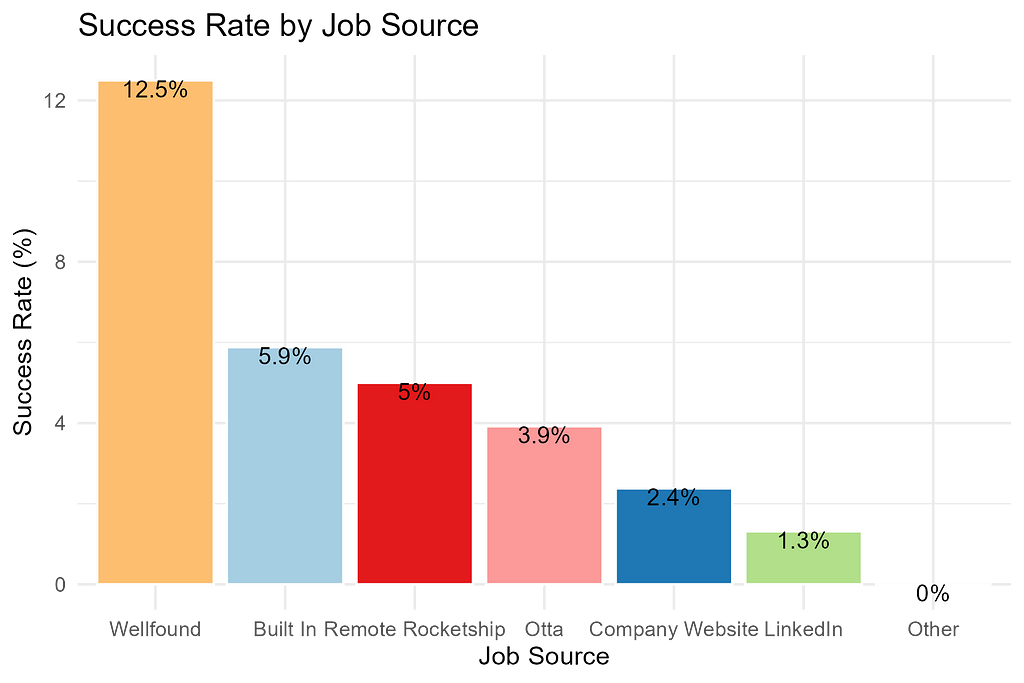
Of all the job boards I used, I found that applications submitted to jobs posted on Wellfound, Built In, and Remote Rocketship had the highest success rates.
Customized Resumes Don’t Help
The prevailing advice is to customize your resume for each position you apply to. With this in mind, I set a goal of a 30% customization rate. I tried a few paid AI services but found them laughably ineffective, and they didn’t really save any time. I ended up using Overleaf’s LaTeX editor and manually updating my skills and job responsibilities based on each job description.
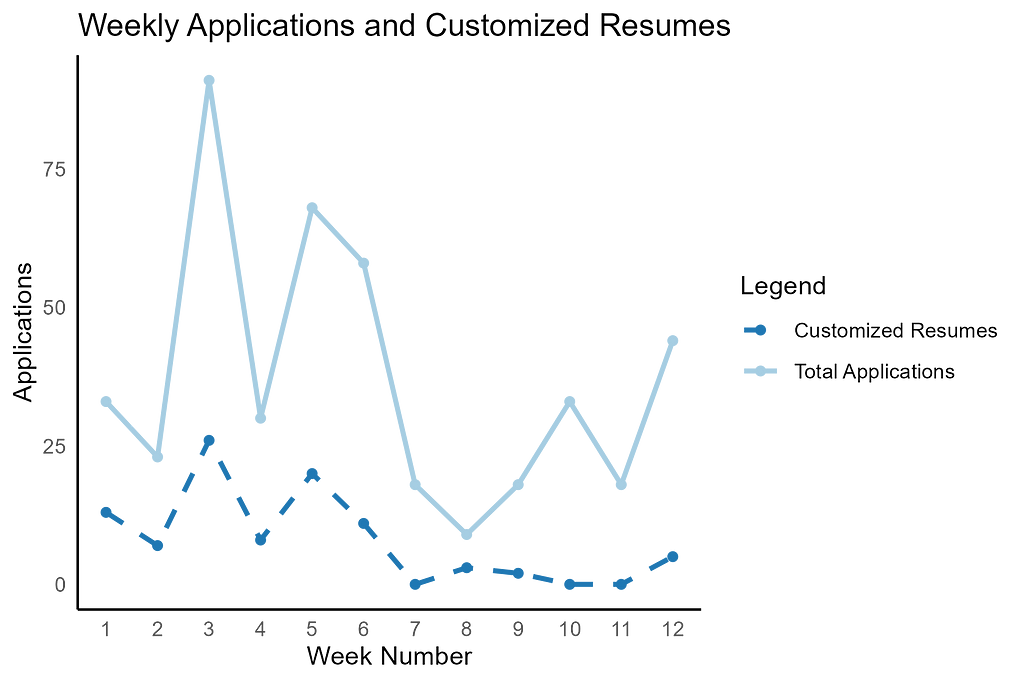
I maintained a customization rate of over 30% for the first month and a half, but it was extremely time consuming, and I got burnt out on the extra effort. Eventually, I went back to using a handful of generalized resumes that included the most commonly used tools and responsibilities and hoped that was good enough. When I compared the results of using the customized resumes versus the ‘good enough’ versions, surprisingly there was no real difference in rate of interview requests.

I was shocked that putting in all the extra effort to customize my resume didn’t appear to make a difference in whether I received an interview invite. I even did a statistical analysis, which confirmed that fully customized resumes did not perform any better than generic versions. This finding could easily have saved me ten hours a week.
Job Titles and Self Confidence
I have about four years of experience in analytics and engineering and applied to a wide range of job titles that fall under the data science umbrella.
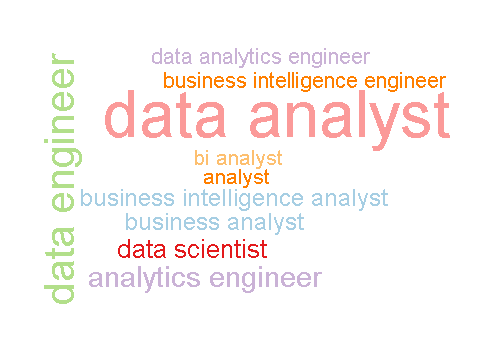
In my experience, jobs that include the word “analyst” are usually less technical and don’t pay quite as much as those ending in “scientist” or “engineer.” My academic background positions me well for one of those science or engineering jobs, but my work experience has been more towards the analyst level and scope. Because of this, I felt comfortably qualified for junior to mid-level analytics engineer and data analyst roles, while pure data science and data engineering opportunities felt like more of a stretch. Business analyst opportunities tend to be even less technical. The types of positions I applied for reflected my assumptions about my strength as a candidate and the competitiveness of the job market.

If you had asked me what my career goals were, I would have told you landing a data science or engineering position was my dream. But I considered myself more qualified for data analyst roles, and so I spent the most time searching and applying for those opportunities.
It turns out I was completely wrong. The success rate of my applications did not mirror my self-assessment. I was actually offered interviews for data science and data engineer positions at a higher rate than for data analyst roles. I had a 219% greater chance of landing an interview for a data science position than a data analyst role, but I applied to them 82% less often because I assumed I wouldn’t be successful.
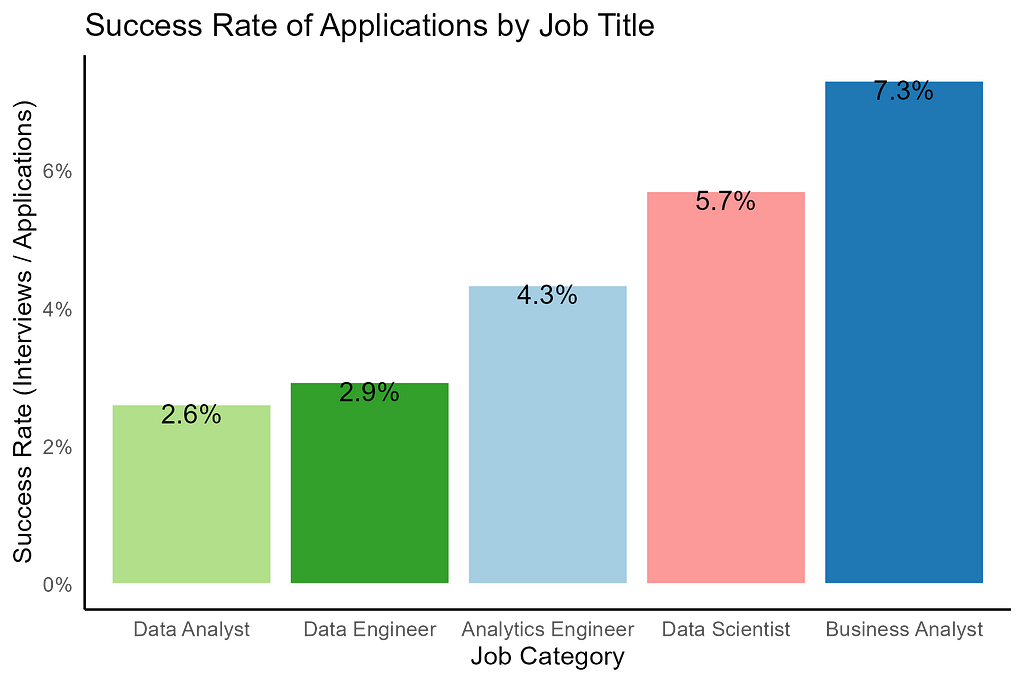
There seems to be no correlation between how I rated my qualifications for a job title and how often I got an interview relative to how many applications I submitted. I may have been sabotaging my own efforts by applying to fewer data science and engineering jobs because I lacked confidence in my skills.
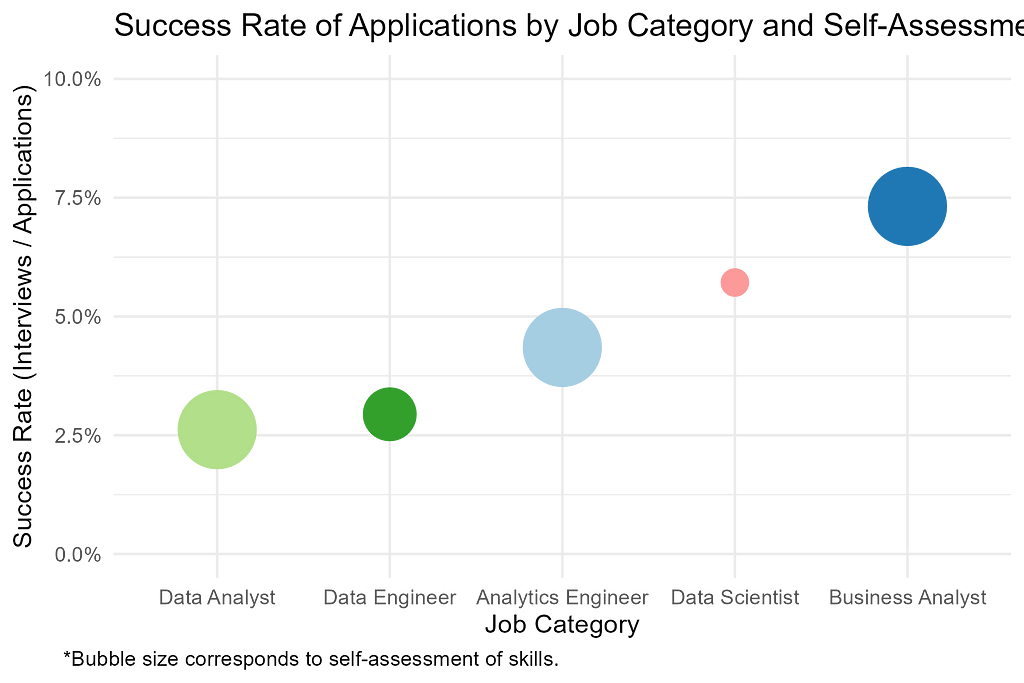
Ghosting is Real
Out of all 443 job applications I submitted, I received just over 100 responses where the company declined to move forward with my candidacy. Eight of these were because the positions were canceled or put on hold. If you do the math, that means 72% of companies that I applied to never responded to my application at all. Job applications take a considerable amount of time, and it’s surprising how many companies don’t follow-up with candidates.
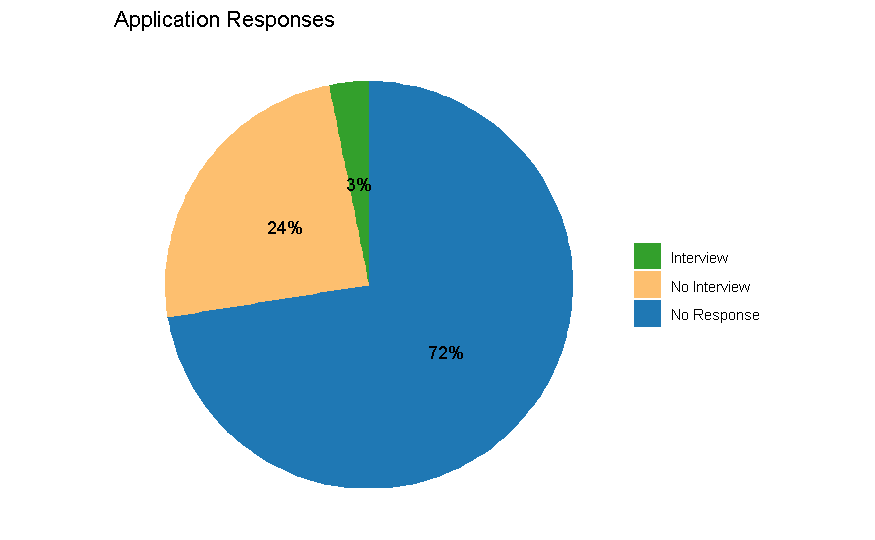
On average, companies responded 5 days faster when extending an interview invitation as opposed to a rejection. I observed an average 12.6 day response time for successful applications, compared to 17.9 days for declines. In most cases if it’s been more than two weeks since applying and you haven’t heard anything, that’s a good sign to move on and keep looking.
What I Learned
I did receive an offer in the third month of my search for a Business Intelligence Analyst position at a small company. I ended up declining the offer for reasons that I might just have to write a whole other blog about to explain. But in short, it wasn’t the right opportunity, and I chose to keep looking.
In a strange twist of fate, there was actually a second offer I received from an application I submitted a month before I started tracking this data. I applied for a data science position with the federal government in May, was called for an interview 4.5 months later in September, and after one 30-minute call with the hiring manager (which I thought I bombed), I got a job offer the next business day.
The experience of interviewing is invaluable, but even after all this practice, I still struggle with confidence and have trouble articulating my skills and abilities. Exploring this data analysis has helped me realize that even though I ultimately found a great job, I should continue to work on recognizing my strengths and accomplishments. Furthermore, almost all of my initial assumptions about where to find jobs, how to apply, or what roles to target turned out to be wrong. While my journey on this path is finally coming to an end, I hope the insights from my experience can also help others make more informed decisions on how to best use their time and energy.
Let this be the final lesson: You never know when doors will open for you. Keep your head up, keep trying, and stay positive. It’s a tough job market, but it won’t be like this forever. And if you are fortunate enough to have the resources to continue searching, never take a questionable offer. If you see red flags, don’t ignore them. Companies may have the upper hand right now, but that doesn’t mean you should compromise on what’s important to you. If it’s a bad fit, keep looking — other opportunities will come along. Never be afraid to put yourself out there, and always remind yourself of your worth. And for the final hot takeaway, stay off LinkedIn, apply for jobs even if you think they are a stretch, and don’t waste too much time customizing your resume!
All data visuals were created by the author using R. The full analysis and sample data set is available on GitHub.
Cruel Summer was originally published in Towards Data Science on Medium, where people are continuing the conversation by highlighting and responding to this story.
Originally appeared here:
Cruel Summer
